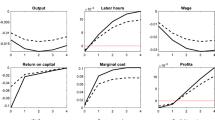Abstract
The paper proposes an intertemporal equilibrium model that highlights the interdependence between aggregate investment and the degree of product differentiation with free entry of monopolistic producers. An investment externality is identified that results in underaccumulation of capital in the decentralized market equilibrium. Some form of investment promotion is called for. The paper compares the effectiveness of a general investment tax credit and an ad valorem output subsidy with policies that favor smaller business size. It is also shown that the complementarity among individual investments creates a potentially powerful investment multiplier.
Similar content being viewed by others
References
Basu, Susanto and John G. Fernald. (1997). “Returns to Scale in U.S. Production: Estimates and Implications.” Journal of Political Economy 105, 249–283.
Blanchard, Olivier J., and Nobuhiro Kiyotaki. (1987). “Monopolistic Competition and the Effects of Aggregate Demand.” American Economic Review 77, 647–666.
Broer, Peter D. and Ben J. Heijdra. (1995). “The Intergenerational Distribution Effects of the Investment Tax Credit Under Monopolistic Competition.” University of Amsterdam and Erasmus University, mimeo.
Chatterjee, Satyajit and Russel W. Cooper. (1993). “Entry and Exit, Product Variety and the Business Cycle.” Cambridge: NBER DP No. 4562.
Cooper, Russell and Andrew John. (1988). “Coordinating Coordination Failures in Keynesian Models.” Quarterly Journal of Economics 103, 441–463.
Davis, Steven and John Haltiwanger. (1990). “Gross Job Creation and Destruction: Microeconomic Evidence and Macroeconomic Implications.” NBER Macroeconomics Annual, 126–168.
De Long, J. Bradford and Lawrence H. Summers. (1991). “Equipment Investment and Economic Growth.” Quarterly Journal of Economics 106, 445–502.
Devereux, Michael B., Allen C. Head and Beverly J. Lapham. (1996). “Monopolistic Competition, Increasing Returns, and the Effects of Government Spending.” Journal of Money, Credit, and Banking 28, 233–254.
Dixit, Avinash K. and Joseph E. Stiglitz. (1977). “Monopolistic Competition and Optimum Product Diversity.” American Economic Review 67, 297–308.
Dixon, Huw and Neil Rankin. (1994). “Imperfect Competition and Macroeconomics: A Survey.” Oxford Economic Papers 46, 171–199.
Domowitz, Ian, R. Glenn Hubbard and Bruce C. Petersen. (1988). “Market Structure and Cyclical Fluctuations in U.S. Manufacturing.” Review of Economics and Statistics 70, 55–66.
Grossman, Gene M. and Elhanan Helpman. (1991). Innovation and Growth in the Global Economy. Cambridge: MIT Press.
Hall, Robert E. (1988). “The Relation Between Price and Marginal Cost in U.S. Industry.” Journal of Political Economy 96, 921–947.
Heijdra, Ben J. (1994). “Fiscal Policy in a Dynamic Model of Monopolistic Competition.” University of Amster–dam: Tinbergen Institute DP TI 94–133.
Heijdra, Ben J. and Frederick van der Ploeg. (1996). “Keynesian Multipliers and the Cost of Public Funds Under Monopolistic Competition.” Economic Journal 106, 1284–1296.
Hornstein, Andreas. (1993). “Monopolistic Competition, Increasing Returns to Scale, and the Importance of Productivity Shocks.” Journal of Monetary Economics 31, 299–316.
Jovanovic, Boyan. (1993). “The Diversification of Production.” Brookings Papers: Microeconomics, 197–247.
Judd, Kenneth L. (1995). “The Optimal Tax Rate for Capital Income is Negative.” Hoover Institution and National Bureau of Economic Research, mimeo.
Keuschnigg, Christian and Wilhelm Kohler. (1996a). “Commercial Policy and Dynamic Adjustment Under Monopolistic Competition.” Journal of International Economics 40, 373–409.
Keuschnigg, Christian and Wilhelm Kohler. (1996b). “Austria in the European Union: Dynamic Gains from Integration and Distributional Implications.” Economic Policy 22, 155–211.
King, Robert G. and Sergio Rebelo. (1990). “Public Policy and Economic Growth: Developing Neoclassical Implications.” Journal of Political Economy 98, S126–S150.
Kiyotaki, Nobuhiro. (1988). “Multiple Expectational Equilibria Under Monopolistic Competition.” Quarterly Journal of Economics 103, 695–713.
Mankiw, Gregory N. (1988). “Imperfect Competition and the Keynesian Cross.” Economics Letters 26, 7–13.
Mankiw, Gregory N. and Michael D. Whinston. (1986). “Free Entry and Social Inefficiency.” Rand Journal of Economics 17, 48–58.
Matsuyama, Kiminori. (1995). “Complementarities and Cumulative Processes in Models of Monopolistic Competition.” Journal of Economic Literature 33, 701–729.
Rebelo, Sergio. (1991). “Long–Run Policy Analysis and Long–Run Growth.” Journal of Political Economy 99, 500–521.
Romer, Paul M. (1987). “Growth Based on Increasing Returns Due to Specialization.” American Economic Review 77, 56–62.
Silvestre, Joaquim. (1993). “The Market–Power Foundations of Macroeconomic Policy.” Journal of Economic Literature 31, 105–141.
Author information
Authors and Affiliations
Rights and permissions
About this article
Cite this article
Keuschnigg, C. Investment Externalities and a Corrective Subsidy. International Tax and Public Finance 5, 449–469 (1998). https://doi.org/10.1023/A:1008693121752
Issue Date:
DOI: https://doi.org/10.1023/A:1008693121752




